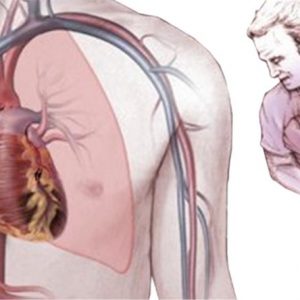In children the circulation is carried out after birth on the same arterial system and the venous plexus in adults. A special place in the circulatory system is the portal vein, the main task of which is to divert blood from the liver tissues.
If she is struck in any process, it may be a special condition of portal hypertension (sharply increased pressure on the portal vein and outgoing vessels).
In adulthood, this abnormality is the result of long-term problems with the liver, vascular lesions and circulatory disorders, what factors it can provoke among children?
The reasons vary greatly at different ages, but a feature of the disease is the possibility of complete cure when timely performed surgical correction of portal hypertension. What are the causes and characteristics of symptoms, occurrence of portal hypertension in infants and older children, what are the methods of treatment applicable to different age groups.
Why is there portal hypertension?
Vascular branches of the portal vein collects venous blood from the digestive system – stomach, all parts of the intestine region of the pancreas, blood vessels nutrients delivered to the liver for processing them for the needs of the body, and also for inactivation of toxins and other substances within it. Under normal conditions, the pressure of blood in the veins is low, much lower than in blood, and it flows slowly, and the walls of the veins pliable and strongly stretched. Portal hypertension, by definition, is increased venous pressure in portal (or another portal) vein.
About the disease say when the pressure inside the vessels in the region of the portal vein rises above 200 mm water column.

Typically, a pressure increase develops in critical situations if the blood formed a barrier in the form of blood clots or adhesions. It can be in the form of venous blood clots, tumors compressing the vein on the outside of the obstacles are localized inside the liver.
Starting from these data, there are several variants of portal hypertension:
- Mechanism of extrahepatic portal hypertension, is implemented as a result of thrombosis in the area of large vessel is a mechanical obstacle to the passage of blood through the vessels. Can also disrupt the structure of the portal vein. In children the typical abnormalities of its structure innate character or the development of tumors inside the vessel.
- hepatic portal hypertension is associated with the formation of polycystic lesions in the liver or cirrhotic change it, and also as a result of the formation of hepatitis, lesions of metastases.
- suprarenal variant of portal hypertension. The mechanism is associated with the excess volume of blood inside the veins of the portal space. This phenomenon is associated with circulatory problems in the heart and lungs.
Especially difficult is portal hypertension on the background of the development of heart failure.
- combined form of hypertension is formed during the development of liver cirrhosis or severe hepatitis.
Characteristics of lesions in children: involvement of the liver
In the period of childhood it is important to distinguish between portal hypertension, in the development process where the pathology involves the tissue of the liver and suffers its circulation, from the form against which the excess pressure in the portal vein system is not affected on the liver tissue. In General, the problem consists in its core of two influencing factors – impaired blood flow through the veins of the portal zone (flow is impeded), also increased blood flow to the liver.
If liver tissue is not involved in the process, and the obstacle is located to the area of the sinuses of the liver (branches of the vessels in its shares), the functions of the authority is almost not violated, no problems with blood clotting and ascites (accumulation of fluid in the abdominal cavity). Can be bleeding in the region of the esophageal veins and gastric partially, but they are minor and the prognosis and correction of the pathology of the good.
If there is involvement of liver tissuewhen there is an obstacle already within the venous vessels of the liver, it is formed by violation of the functions and structure of the body suffers, the blood circulation the cells of the liver, violated its basic functions in protein synthesis, clotting factors, and it quickly leads in addition to all the accompanying symptoms to liver failure.
The causes of pathology: congenital and acquired factors
If it disrupts the outflow of blood from the liver, there is a Budd-Chiari, it can still call occlusive disease of the liver. The most frequently formed as congenital portal vein rarely becomes the result of thrombosis in the region of the Vena cava or the hepatic vessels. Health problems arise on the background of increasing pressure in the veins and suffering because of this liver functions.
Extrahepatic causes of hypertension:
- Chronic liver disease (fibrotic, cirrhotic lose)
- Viral hepatitis, congenital atresia of the biliary tract
- Wilson Disease-Konovalova
- The alpha-trypsin
Against the background of these factors in addition to suffering liver are jaundice, an increase in circumference of the abdomen due to dropsy, significant developmental delay – physical and psychomotor.
Extrahepatic causes of hypertension:
- Violation of the lumen and patency of the portal vein
- Inflammation of the umbilical wound – omphalitis, installation of a catheter in the umbilical vein
- Sepsis, infection in the abdomen
- Dehydration
- The unknown factors.
If there is obstruction of the venous vessel, begin to form alternative variants of venous vessels, which formed the bloodstream bypassing the inflamed and clogged veins. It is called cavernous transformation of portal vessel. Suffer veins inside the liver and around it, and you can marvel at the veins in the region of the colon, spleen and the area of the retroperitoneal space. In these veins the blood can return to heart, thus bypassing the liver. It is especially dangerous when on the background such pathology dilate the venous plexus in the esophagus or stomach, enlarged and rend the veins can form of serious hemorrhage.
Signs of portal hypertension in children
In many ways, the clinical manifestation of hypertension depends on its cause, and have a fairly typical appearance. But each form has its own typical features by which it can be distinguished from all others by which this form of threat to children’s health.
Extrahepatic form of portal hypertension in children
When extrahepatic form of disease, the first manifestation of a high pressure in the portal vein is formed very early and rapidly. The first of these is an increase in stomach size and a constant causeless diarrhea, increased pressure of unknown origin, enlargement of the spleen and the appearance of hemorrhages under the skin in the legs. The examination of the blood revealed a decrease in the number of all cells – erythrocytes, platelets, and leukocytes that is associated with the dysfunction of spleen with its increase.
Often the first symptom of portal hypertension becomes a bleed in the esophageal veins and cardiac (cardia of stomach). It occurs in apparently healthy children, and is formed in the first six years of life in 85% of children. But in the survey there are no changes of liver enzymes or they are insignificant. After bleeding you may experience symptoms of ascites – accumulation of fluid in the abdomen.
Intrahepatic form of portal hypertension in children
On the background of intrahepatic hypertension symptoms of high blood pressure superimposed on the symptoms that gives you cirrhosis of the liver. This usually occurs after 5 years or more since the child suffered from hepatitis. So, leading will liver damage with the development of weakness and fatigue in habitual exercise, weight loss and pain in the abdomen and right side, a feeling of heaviness in the epigastric area, disorders of stool and digestion, bleeding vessels, subcutaneous hemorrhage, gum problems.
As the progression of pathology change as the size of the liver and its density. In the initial period it slightly increased with a smooth surface and uniform density. As far-reaching changes in the liver increases dramatically with increased density and hillocks on the surface. Against the backdrop of the growth of typically the liver and enlargement of the spleen with formation of such a state as hypersplenism (increased destruction of body cells).

The examination and analyses manifest the typical changes of liver function – increase of bilirubin level, and particularly due to the direct fraction. Also typically decrease the level of protein plasma, the violation of the ratio of albumin to globulins, the suffering of antitoxic functions of the liver. Not always clearly reveals the relationship between changes in the tests and the level of pressure in the portal the vein, which is associated with high contingency and functional abilities of the liver.
Closer to adolescence begin to develop bleeding in the region of the esophageal veins and the increase in size of the abdomen because of ascites. Perhaps the increased venous pattern on the abdomen because of enlargement of the venous plexus and the formation of dark stools (melena) on the background of bleeding from the upper digestive tube.
Methods of detection of pediatric portal hypertension
The basis of diagnosis of elevated pressure in the portal vein is the holding ultrasound of abdomen and liver, spleen and simultaneous Doppler all major veins departing from the digestive organs. Typical symptoms for the development of intrahepatic forms of pathology will be quite normal structure of the liver and a special (cavernous) transformation in the area most of the portal vein.

If this is the parenchymatous form of hypertension, the liver will be compacted, and the area of the portal vein passable throughout it.
Suprarenal hypertension may identify the area of obstruction of hepatic veins or zones of the inferior Vena cava.
When performing Doppler studies of the veins there is a marked reduction of blood flow in the area of venous vessels. The indicators change dramatically, indicating problems with the delivery of blood and the outflow of her back.
Also demonstrates the use of endoscopy for examination of the mucous of the esophagus and the stomach, identifying the enlarged and bleeding veins. Can be identified as a special kind of gastropathy – the defeat of the stomach in the background disturbed outflow veins of the liver. Often in the field of veins of the esophagus or cardia of the stomach can occur the ruptures of veins, which leads to sudden bleeding, which can be both minor and massive and life-threatening. Of the other vessels of the digestive tract bleeding may be extremely rare.
If the doctors doubt the diagnosis, or is planning surgical treatment, it is important to conduct angiography of visceral vessels, and methods are selected individually in order to visualize the most active affected area.
Additionally appointed a liver biopsy in case of suspected cirrhosis or define other hepatic lesions, which can lead to the development of hypertension.
By external examination draws attention to the presence of bruises and hemorrhages on the body, enlarged veins around the navel, increasing the size of the stomach and General malaise, pallor. When palpation of the liver and spleen may be an increase, seal and tuberosity. Can be one of the symptoms of disease the presence of blood platelets is reduced.
Methods of treatment of diseases in children
How to treat hypertension is handled individually and can be used as medical intervention and surgical correction. It depends on the age of children and severity of hypertension, of disorders caused by it in the state of the baby. Usually the drug is administered to stop bleeding or reduce pressure on the portal vein, to eliminate the changes in blood composition.
When surgical intervention can be used different methods of intervention, ranging from minimally invasive endoscopic techniques to the global abdominal surgery and in severe cases a liver transplant.
The medication will be shown the use of diuretics that remove excess fluid from the body. This reduces the pressure in the veins, helps to reduce ascites. Also shows hemostatic agents, beta-blockers, nitrate compounds, hormonal agents.
To normalize the amount of fluid in the body shows a strict drinking regime and diet with a Foundation in the form of boiled vegetables and soups, which is necessary when treating with medicines or before surgery to stabilize the pressure. In the diet exclude salt, reduce the amount of protein to 30 grams per day, which will help to avoid complications during the operation of the vessels. The doctor in each case leaves the list of prohibited and permitted meals on the basis of which is made a diet of the child. This is usually vegetable soups and second courses with a sharply reduced amount of meat or fish.



